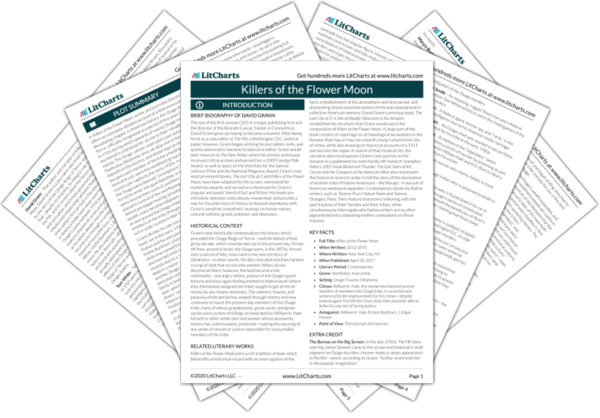Throughout Killers of the Flower Moon, one potent symbol recurs: clothing. Clothing functions as a method of self-expression and self-identification for the real-life “characters” Grann reanimates through a combination of historical record and imagination, and additionally symbolizes, for many characters, the struggle to preserve one’s identity in the face of oppression and intimidation.
For Mollie Burkhart—an Osage woman who has, throughout her life, struggled with the humiliations of assimilation (and the greater humiliations of refusing to assimilate), clothing becomes a way for her to remain somewhat attached to her culture and her heritage despite her family’s having become “unmoored” from many of their tribal traditions. Mollie is frequently dressed in a traditional Indian blanket—as is her sister Anna, before her death. As Grann reveals that in the Catholic school the girls attended, they were forbidden from dressing in tribal clothing or speaking their native tongue, it becomes clear that Mollie and her sisters use their Indian blankets in conjunction with more Americanized dress in order to preserve a piece of their culture and assert to their family, to their neighbors, and to themselves that their past will not be so easily erased.
Clothing is also a symbol identity preservation for former Texas Ranger turned federal agent Tom White and J. Edgar Hoover, his boss at the bureau of investigation (soon to become the FBI). White is a “cowboy” of a man—imposingly tall and large, he was the son of a hangman in Texas and more or less grew up on the grounds of a jail. His rough-and-tumble past working with the Rangers has instilled in him a frontiersman’s disposition—one that is threatened by increasingly constricting rules about dress code and manner at the bureau. The vain and controlling Hoover—insecure about his short stature and fearful of having any of his subordinate agents exude more power than him—looks down on lawmen like White who proudly wear large cowboy hats and shirk a demure, East-coast, “college-boy” look. The sartorial struggle between Hoover and White is representative of the larger power struggle between the men; as Hoover seeks to mold the fledgling bureau to his standards, White and many men like him are in danger of being pushed out for their untraditional backgrounds, tactics, and indeed appearances.
The final character to whom clothes are an important symbol is the evil William K. Hale—a former cattle rancher who, by the 1920s, had risen to prominence in Osage county and was commonly known as the “King of the Osage Hills.” Hale was in favor with nearly everybody—his jaunty, generous disposition and congeniality, however, masked a much darker reality. The scheming Hale was covetous of the Osage tribe’s wealth, and through a complicated network of bribery, corruption, and general lawlessness (which involved store proprietors, doctors, policemen, bankers, and even outlaws hiding in the hills) had backed or even orchestrated several plots to poison, shoot, and otherwise dispatch prominent Osage tribe members to obtain their headrights. Hale is depicted both in photographs and in Grann’s descriptions as always finely dressed, often in a “dandy” three-piece suit and bowtie, along with fine fedoras and pert round glasses. In Hale’s case, he uses his outward appearance—once which effects wealth, propriety, and order—to mask the dark, chaotic, and evil force within him that drives him to commit egregious and notorious crimes.
Clothing Quotes in Killers of the Flower Moon
The public had become transfixed by the tribe's prosperity, which belied the images of American Indians that could be traced back to the brutal first contact with whites—the original sin from which the country was born. Reporters tantalized their readers with stories about the “plutocratic Osage” and the “red millionaires,” with their brick-and-terra-cotta mansions and chandeliers, with their diamond rings and fur coats and chauffeured cars. One writer marveled at Osage girls who attended the best boarding schools and wore sumptuous French clothing, as if “une tres jolie demoiselle of the Paris boulevards had inadvertently strayed into this little reservation town.”
At the same time, reporters seized upon any signs of the traditional Osage way of life, which seemed to stir in the public's mind visions of “wild” Indians. One article noted a “circle of expensive automobiles surrounding an open campfire, where the bronzed and brightly blanketed owners are cooking meat in the primitive style.” Another documented a party of Osage arriving at a ceremony for their dances in a private airplane—a scene that “outrivals the ability of the fictionist to portray.” Summing up the public's attitude toward the Osage, the Washington Star said, “That lament, 'Lo the poor Indian,' might appropriately be revised to, 'Ho, the rich redskin.”'

Unlock explanations and citation info for this and every other Killers of the Flower Moon quote.
Plus so much more...
Get LitCharts A+Lizzie relied on Mollie to deal with the authorities. During Lizzie's lifetime, the Osage had become dramatically unmoored from their traditions. Louis F. Burns, an Osage historian, wrote that after oil was discovered, the tribe had been “set adrift in a strange world,” adding, “There was nothing familiar to clutch and stay afloat in the world of white man's wealth.” In the old days, an Osage clan, which included a group known as the Travelers in the Mist, would take the lead whenever the tribe was undergoing sudden changes or venturing into unfamiliar realms. Mollie, though she often felt bewildered by the upheaval around her took the lead for her family—a modern traveler in the mist. She spoke English and was married to a white man, and she had not succumbed to the temptations that had hurt many young members of the tribe, including Anna. To some Osage, especially elders like Lizzie, oil was a cursed blessing. “Some day this oil will go and there will be no more fat checks every few months from the Great White Father,” a chief of the Osage said in 1928. “There'll be no fine motorcars and new clothes. Then I know my people will be happier.”












